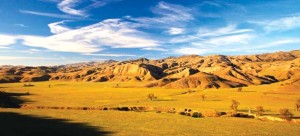With a name like “fracking,” there’s just no way the oil drilling process couldn’t lend itself to conflict.
With controversy over fracking heating up, environmental activists gathered at San Francisco’s Crissy Field as part of the international “Global Frackdown” demonstrations taking place around the world. Led by Washington D.C. -based nonprofit Food and Water Watch, the movement aims to ban the shale drilling process known as hydraulic fracturing, or “fracking,” and the September 22 event was the first coordinated international day of action.
In California, fracking and oil drilling is already present in the Sacramento area and the Delta, but the Monterey Shale formation, which stretches half the length of the state, could end up being bigger than the Alaskan field.
The crowd of about 70 people in San Francisco was made up of Bay Area residents, members of the Occupy Movement, Code Pink, and several environmental advocacy groups. Protestors chanted, “Ban Fracking Now!” carried strongly worded signs, distributed petitions and gathered to hear speakers.
Members of the Center for Biological Diversity brought a nearly 50-foot sheet listing all of the known carcinogenic chemicals used in fracking, and others hung a hand-made banner stating, “Don’t Frack the Bay.” From specifically targeted signs reading, “California Condors Against Fracking,” to the broader, “No Frickety Fracking,” the sentiment was the same.
“Here in California, we are being drilled for both natural gas and oil, “ Adam Scow, California Campaigns Director for Food and Water Watch said to the crowd. “There are these enormous power brokers –like Exxon and Chevron – who want the state to do nothing, and we are here to get the ball rolling on legislative action against fracking.”

Fracking is a drilling process that blasts millions of gallons of water mixed with chemical-laced sand underground to release natural gas and oil from tight rock formations. Officially, there is no overall scientific consensus on the process. Some say that an increase of natural gas helps drive down air pollution from dirtier fuels like coal, while others argue its just another dirty fossil fuel. It is currently unregulated, and disclosing fracking activity to the public is not mandatory.
“Fracking is the most destructive process of energy extraction, and almost half of the people in California don’t even know what it is,” said Shannon Biggs, director of the Community Rights Program at Global Exchange. “It’s unregulated and unmonitored. We need to organize and stand together to stop it.”
After a decade of fracking, it’s become increasingly controversial across America. In states like Texas and Pennsylvania, drilling and fracking has been linked to both environmental and economic hazards. Water contamination, air pollution and toxic waste dumping have all been associated with fracking, along with decreased property value on land used for drilling.
In California, activists say the Sacramento Delta and the Monterey Shale formations are considered regions vulnerable to fracking.
“There are nine counties in California that would be directly affected by fracking,” said Rose Braz, Climate Campaign Director for the Center for Biological Diversity. “The Monterey Shale holds 40 percent of the nation’s oil. Allowing fracking there would be like lighting a fuse on a huge carbon bomb.”
While information on fracking can be difficult to acquire, activists mostly rely on oil company press releases or FracFocus, an online chemical disclosure registry. The inherent problem with getting information here is that it is an industry-run, voluntary website. Since there are currently no regulations on fracking, little transparency exists.
After nearly an hour of speeches, chanting, picture taking and a small altercation with US Park Police over the use of signs, the demonstration took to the street. Throngs of activists chanted and beat drums all the way to the Golden Gate Bridge, in hopes that the Global Frackdown will serve as a wake-up call to citizens and members of government.
“This is the first step in informing the public on what’s really happening,” said Jennifer Krill, executive director of Earthworks. “This situation is a violation of the rights of the public to know what’s happening in our watersheds, next to our schools, in and our vineyards and farms.”
Heather Mack is a Bay Nature editorial intern.




